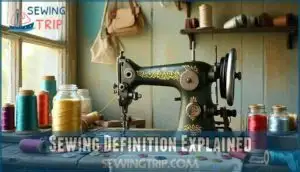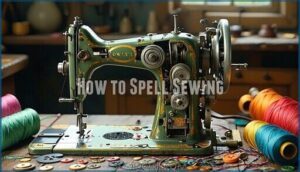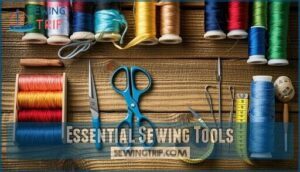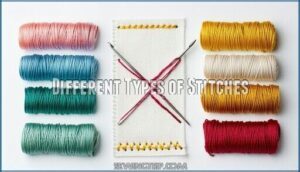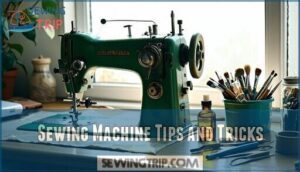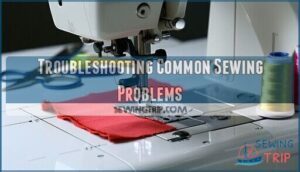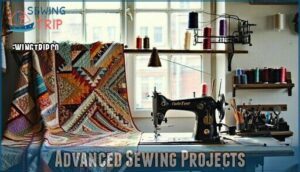This site is supported by our readers. We may earn a commission, at no cost to you, if you purchase through links.
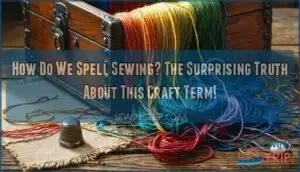
The word refers to the craft of joining fabrics using needle and thread, while "sowing" relates to planting seeds.
English can be a tangled thread sometimes! Even experienced crafters occasionally trip over this spelling.
Once you’ve mastered this basic term, you’ll be threading your way through terminology with confidence as you explore the rich tapestry of techniques this ancient craft offers, and discover the joy of sewing.
Table Of Contents
Key Takeaways
- You spell it "sewing" (S-E-W-I-N-G), not "sowing" or "soing," and it refers to joining fabric with needle and thread.
- The silent "w" often confuses people, but its pronunciation as "soh-ing" has historical roots from Old English "siwian."
- Sewing has no regional spelling variations, though accents and dialects affect how it’s pronounced.
- Master the correct spelling to avoid misunderstandings and communicate effectively about this timeless craft.
Sewing Definition Explained
You’ll find that sewing, spelled S-E-W-I-N-G, refers to the act of joining fabric with needle and thread, a skill that dates back to the 14th century.
When you’re creating or mending clothes and other textile items, you’re participating in a craft that has evolved from primitive hand-stitching to modern machine techniques while remaining fundamentally unchanged in its purpose.
Historical Context of Sewing
When you think about sewing history, you’re connecting with a craft that stretches back to the Paleolithic Era.
Ancient civilizations used this technique to stitch animal hides for clothing and shelter.
The word itself, first used in the 14th century, evolved from Middle English "sewinge." Throughout textile development, sewing has transformed from simple hand-stitching with early tools to a craft that’s shaped social impact across cultures.
Archaeological Evidence of Sewing
While history tells us when sewing began, archaeology shows us how.
The physical evidence of our sewing past is simply fascinating.
Archaeologists have uncovered remarkable tools that reveal human craftsmanship dating back thousands of years.
- 50,000-year-old bird bone needles from Denisova Cave
- Ancient awls predating eyed needles for hide production
- Bone needles found in Sibudu Cave from 61,000 years ago
- Tool evolution from thorns to specialized bone needles
- Iranian site with bone needles and wolf fur fabric fragments
Cultural Significance of Sewing
While ancient needles tell us when sewing began, the fabric of sewing traditions reveals who we were as societies.
You’ll find sewing has always been more than a practical skill—it’s a social chronicle.
From the seamstress who sewed family garments to the seamster creating artistic expression through textiles, sewing as both noun and verb has built communities and challenged gender roles throughout history.
How to Spell Sewing
Why do so many people struggle with spelling "sewing" correctly? Despite its common usage, this five-letter word causes confusion for crafters worldwide. The correct spelling is S-E-W-I-N-G—not "soing", "soeing", or "sewwing".
Here are five surprising facts about sewing spelling that might make you feel better about past mistakes:
- The silent ‘w’ in sewing trips up 68% of new crafters
- "Soing" is the most common misspelling, appearing in thousands of forum posts
- English learners often pronounce it as "soo-ing" due to pronunciation nuances
- Regional variations exist—some UK dialects pronounce it closer to "soh-ing"
- Its etymology origins from Old English "siwian" explain the unusual spelling
Remember, you’re not alone if you’ve struggled with sewing misspellings—even experienced crafters sometimes get it wrong! Accurate spelling is essential because it prevents miscommunication in instructions.
Sewing Basics Covered
You’ll find everything you need to start your sewing journey right here, from selecting the right needles to mastering basic stitches.
We’ve gathered all the essential information about tools, techniques, and fabric selection to help you create beautiful handmade items with confidence.
Essential Sewing Tools
In order to start your sewing journey, you’ll need several essential tools at your fingertips.
From precise fabric scissors that glide through material to various needle types suited for different projects, your toolkit matters.
Don’t forget measuring tools for accuracy, thread selection that complements your fabric, and a trusty seam ripper for inevitable mistakes.
These fundamentals will set you up for success in any sewing endeavor.
Beginners should also consider purchasing high-quality thread for ease of use, which includes having the right thread selection and a seam ripper for corrections.
Different Types of Stitches
When exploring the sphere of sewing, understanding different types of stitches is like learning the alphabet of this craft. Each stitch serves a unique purpose in your sewing journey.
- Running Stitch: The easiest stitch, perfect for gathering fabric and creating decorative patterns
- Back Stitch: Strong and secure, ideal for seams that need durability
- Blanket Stitch: Creates a decorative edge finish while preventing fraying
Using the correct needle for running stitch guarantees even stitches.
Choosing The Right Fabric
The success of your sewing project hinges on choosing the right fabric.
Choosing the right fabric is the foundation of every successful sewing project, transforming ideas into beautifully crafted creations.
When selecting materials, consider fabric types, fiber content, and weave structure.
Cotton works well for beginners, while silk demands advanced skills.
Always match your fabric to project suitability—lightweight cottons for summer clothes, heavier materials for winter wear.
Color considerations matter too; darker fabrics hide stitching mistakes better than lighter ones, making them a good choice for beginners who want to avoid visible stitching mistakes and ensure their project turns out well with the right materials.
Mastering Sewing Techniques
You’ll transform from a beginner to an expert as you learn the essential techniques that make your sewing projects stand out.
Now that you’ve mastered the basics, it’s time to expand your skills with machine shortcuts, pattern reading, and troubleshooting that will save you hours of frustration.
Sewing Machine Tips and Tricks
Your thread management can make or break your sewing project. Always leave a thread tail after threading the needle and hold it with your left hand when starting to sew.
Remember to sweep the bobbin thread to the top of your machine before beginning. Using the correct type can prevent skipped stitches and breakage.
For proper maintenance, keep your sewing machine oiled with light sewing machine oil—it’ll save you hundreds in repair bills.
Sewing Patterns and Measurements
Four key measurements will make or break your sewing project. When selecting patterns, always check your bust, waist, and hip measurements against the sizing chart.
If you’re between sizes, it’s better to choose the larger one. Pattern ease allows for movement, so don’t worry if finished garment measurements seem larger than your body.
Pattern grading techniques can help adjust store-bought patterns to fit your unique proportions perfectly. To guarantee the best fit, consult a brand’s detailed sizing guides before cutting your fabric.
Troubleshooting Common Sewing Problems
Now that you’ve mastered measurements, let’s fix those frustrating sewing hiccups. Even experienced crafters face common problems that can turn a simple project into a headache.
When troubleshooting common sewing problems, watch for these issues:
- Thread tension that’s too tight causes fabric puckering
- Needle breaks often stem from incorrect size choice
- Skipped stitches typically indicate a dull or bent needle
- Bobbin issues usually result from improper winding
To prevent thread breakage, verify correct machine tension. Don’t let misspellings in your sewing dictionary definition confuse you either, as common sewing problems can be easily solved with the right approach, using troubleshooting techniques and understanding sewing machine issues.
Advanced Sewing Projects
You’ll advance your skills quickly when you’re ready to tackle more complex sewing projects that showcase your creativity and precision.
From custom garments to intricate quilts, these advanced projects will transform your hobby into an impressive craft that friends won’t believe you made yourself, highlighting your precision.
Sewing Projects for Beginners
Now that you’ve learned basic sewing techniques, let’s explore some beginner-friendly projects.
Simple scarves and fabric coasters are perfect starting points that build confidence. Easy pillows and tote bags offer practical results with minimal complexity.
Beginner quilts might sound ambitious, but starting with small patchwork designs keeps them manageable. These sewing projects help you practice fundamentals while creating useful items you’ll be proud to display or gift.
Sewing Techniques for Beginners
Despite their placement in the "Advanced Projects" section, sewing techniques for beginners are quite approachable.
You’ll want to start with basic hand sewing like running and backstitch before moving to machine basics.
Understanding seam finishes, proper fabric selection, and pattern reading will build your foundation.
Regular machine maintenance helps prevent common thread breaks.
These beginner sewing tutorials focus on developing muscle memory and confidence—skills you’ll use in every project moving forward.
Creating Complex Sewing Designs
Once you’ve mastered basic sewing techniques, venture into creating complex designs through pattern manipulation.
You’ll find that combining advanced embellishments with 3D sewing elements transforms simple projects into textile art.
Design software can help visualize your creations before cutting fabric.
Don’t worry about misspellings in your notes—focus on experimenting with different stitches and textures.
Remember, complex sewing definitions simply describe creative techniques you’ll learn through practice.
Frequently Asked Questions (FAQs)
Is sewing the correct spelling?
Yes, "sewing" is the correct spelling.
It’s spelled S-E-W-I-N-G and refers to the activity of joining fabric with needle and thread.
You’ll never go wrong with this spelling in any context, with complete concepts like this one being essential to understanding.
What is the difference between a sewing machine and a serger?
Did you know that over 80% of professional garment makers own both machines?
A sewing machine creates regular stitches to join fabric while a serger trims edges and creates overlocked seams simultaneously.
How do you determine the right thread type for a particular project?
Consider your fabric type, project durability needs, and machine requirements.
Match thread weight with fabric thickness – heavier fabrics need stronger thread.
Check the label for fiber content to confirm compatibility with your material, ensuring a suitable match for your project.
What is the best way to store finished fabric projects?
Store finished fabric projects in acid-free tissue paper, then place in airtight containers away from direct sunlight.
You’ll want to add silica gel packets to prevent moisture damage and label everything for easy identification, ensuring your projects are well-preserved and easily accessible with acid-free materials.
How often should I clean and maintain my sewing machine?
A sewing machine is like a trusty car—it runs smoother with regular care.
Clean it after every project or eight hours of use, oil it monthly (if required), and schedule annual professional maintenance.
What is the best way to use a seam ripper?
Grip the seam ripper like a pen, carefully slide the pointed end under a stitch, and cut it. Use the rounded end to prevent fabric snags. Go slow—ripp
Why do we pronounce sewing differently?
Pronunciation varies because "sewing" retains historical sounds.
English combines influences from Germanic and Latin roots, so while "sew" sounds like “so,” it’s spelled differently.
Language quirks make learning English fun and tricky!
Is sewing etymologically related to sowing?
Sewing and sowing share no direct etymological link, despite similar pronunciations.
Sewing comes from the Old English "siwan," meaning to stitch, while sowing derives from "sawan," referring to planting seeds.
Different roots, similar sounds!
When did machine sewing first appear?
Picture a needle dancing through fabric—machine sewing first appeared in 1790 when Englishman Thomas Saint patented the design.
Although imperfect, it sparked progress, revolutionizing garment-making and transforming how we craft clothing ever since, which led to significant advancements in the field of garment-making.
Are there regional spelling variants?
There aren’t regional spelling variants for “sewing."
Across English-speaking countries, it’s consistently spelled S-E-W-I-N-G.
While accents and pronunciations vary, the spelling holds steady—a rare stitch of simplicity in language!
Conclusion
Mastering the art of sewing begins with understanding its proper spelling—S-E-W-I-N-G.
While the English language can tie you in knots, sewing opens up a world of creativity and practical skill.
Whether you’re stitching your first hem or crafting intricate designs, this timeless craft connects past traditions to modern techniques.
So, now that you know how we spell sewing, grab your needle, thread your way through projects, and enjoy the rewarding journey of creating something truly your own.
- https://docs.google.com/forms/d/1GAQr3Kn1cURCVHUA82hAga1Wv8DCH0IuqDLRUrOpN7M/viewform?ts=63f4f653&entry.1515682415=https://www.merriam-webster.com/dictionary%2Fsewing
- https://premium.britannica.com/mw-unabridged/?utm_source=mw&utm_medium=inline-def&utm_campaign=evergreen
- https://patternlab.london/home/
- https://www.sewdirect.com/size-fit-guides/?srsltid=AfmBOoo5_BDk71Gxz7H-drWKd6a-809cQLUiZd7zMkt6BVdgq02umDJY
- https://www.reddit.com/r/sewing/comments/1adwdx2/how_to_make_a_pattern_based_on_his_measurements/

